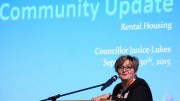Mayor Sam Katz and challenger Judy Wasylycia-Leis went head-to-head on a variety of hot button issues on Oct. 8 at a mayoral candidate forum on downtown issues.
The candidates submitted answers to a list of 10 questions prior to the event, which were then used to direct the moderator’s questions.
Rav Gill and Brad Gross, the two other mayoral candidates, were not invited to participate in the forum.
While much of the discussion was fuelled by the candidates’ plans to improve transportation, issues ranged from crime prevention to funding infrastructure. The audience, made up of many downtown supporters, raised their concerns and demanded answers from the candidates.
Katz and Wasylycia-Leis repeatedly disagreed with each other’s stance, making for heated discussions. While Mayor Katz stated that “things are moving in a positive direction,”
Wasylycia-Leis argued that her opponent was not doing enough in terms of making concrete plans to address issues of transportation, housing and crime prevention.
Wasylycia-Leis stated that there has been no progress in terms of the completion of the city’s bus rapid transit system, which has put the city in a bad light.
Phase One of the bus rapid transit plan set out to create a $138-million bus-way from Queen
Elizabeth Way, near the Forks, to Jubilee Avenue at Pembina Highway. The agreement was announced six years ago by the three levels of government.
“We are completing the first phase of rapid transit. It should be completed by November of next year,” said Katz.
The city was set to begin Phase Two of the corridor, a six-kilometer extension to the University of Manitoba, by 2012. Although Katz has set his sights on the construction of a light rail transit system in Winnipeg, he maintains that the plans to finish Phase Two have not changed.
“We’re also going to have an active transportation all the way, as planned, if the province co-operates, so you can actually have a route that would be parallel all the way down from Crazy Corner to the University of Manitoba,” Katz told the Manitoban.
He said that the route would be done in conjunction with the rapid transit project, so a large portion should also be finished by next November.
“[We] want to plan for the next 30 years, and that’s why we’re looking at LRT [ . . . ]. It’s the future,” said Katz. He said it is proven that in North America, the LRT can increase the number of people who choose public transportation by 44 per cent, referring to a 2004 Calgary Transit report which claims that between 1995 and 2003, annual transit ridership in Calgary increased from 54 million to 78 million.
However, Wasylycia-Leis accused Katz of “flip-flopping” in terms of his transit plans.
“We should finish what we started [ . . . ]. I will get the corridor done within my first term of office,” said Wasylycia-Leis.
“Almost everything I’ve talked about are ideas that can be implemented almost immediately or kick started immediately,” she explained.
“For example, I would absolutely ensure that the rapid transit corridor from the downtown to the U of M is finished as quickly as possible,” she continued.
Winnipeg’s existing transit system was also put under major scrutiny.
“There are serious problems with our transit system,” agreed Wasylycia-Leis.
Katz mentioned that 545 new buses were bought under his authority as well as many new bus shelters.
To address the question of how to get more people living downtown, Katz referred to incentives given by the City of Winnipeg to contractors, encouraging them to make housing more affordable. In the past, grants of $20,000 per door were given and Katz said this amount has now increased to $40,000 per door.
However, Wasylycia-Leis felt that Winnipeg does not have a proper housing strategy.
“It starts by reinvesting in our neighborhoods,” she said. She stated her commitment to increase property taxes by two per cent each year in order to increase revenues.
“Within ten years, I would like to see the population of downtown Winnipeg doubled,” said Wasylycia-Leis.
Supporting the arts in downtown also arose as a priority. Wasylycia-Leis mentioned the need to better acknowledge Winnipeg artists.
“Our artists are among the lowest paid workers in the city,” she said.
Katz said that Winnipeg has greatly increased its support for the arts during his time in office.
He also made note of the Mayor’s Luncheon for the Arts, which he has been hosting for the past four years in order to recognize and promote the arts. This year, the luncheon celebrated Winnipeg’s designation as the Cultural Capital of Canada by the federal government.
The candidates also addressed issues of security in the downtown area. Questions addressed the concern that the main reason why many people don’t go downtown is because they don’t feel it is safe.
Katz mentioned the implementation of a new cadet program. The trainees, who are studying at the Winnipeg Police Service training academy, will be graduating in January. The cadets will help police with basic duties and maintaining safety explained Katz. He also pledged the addition of 20 police officers downtown.
In terms of who won the debate, Chrissy McClung, administrative assistant for Downtown Winnipeg Biz, said she thought the candidates had tied themselves and that it would take a lot of reflection to come to a decision.
“Not one came out better than the other [ . . . ] so it’s really about what issues are important to you,” said McClung.




